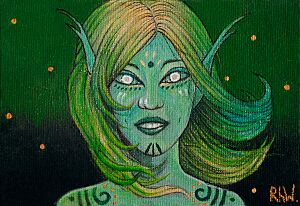- This page was last modified on 17 October 2025, at 10:18. Suggest an edit.
Tylwyth Teg facts for kids
The Tylwyth Teg is the name for fairies in the traditional stories of Wales. The name comes from Middle Welsh and means "Fair Family." These magical beings are a big part of Welsh folklore, much like the Aos Sí are in Irish stories.
People in Wales have also called them by other names, such as:
- Bendith y Mamau ("Blessing of the Mothers")
- Gwyllion
- Ellyllon
Contents
Where Does the Name Come From?
The first time the name Tylwyth Teg was written down was in a poem from the 14th century. It was written by a famous Welsh poet named Dafydd ap Gwilym.
In the poem, a character gets lost in a thick mist while on his way to meet his girlfriend. He blames the "long burden of the Tylwyth Teg" for his bad luck, suggesting the fairies used magic to trick him.
What Are Welsh Fairies Like?
Stories describe the Tylwyth Teg in many different ways. They have special powers, follow certain rules, and can be both helpful and tricky.
Appearance and Behavior
The Tylwyth Teg are often said to have fair or golden hair. They are known for their love of dancing in circles, which are said to create fairy rings in the grass. They are believed to live in hidden places, like underground kingdoms or beneath the waters of lakes.
Some tales say they were fascinated by human children with golden hair and would sometimes kidnap them. In their place, they would leave behind a fairy child called a changeling (or crimbil in Welsh).
A Story About a Changeling
One famous story tells of a mother whose young son was taken by the fairies and replaced with a changeling. A wise man gave her three tasks to get her real son back.
- First, she cracked open an egg, threw away the yolk, and started stirring the empty shell as if she were cooking. The changeling, who looked like a toddler but was actually very old, was so surprised he said something that revealed he was not a normal child.
- Next, she went to a crossroads at midnight during a full moon. There, she saw a parade of fairies and spotted her own son with them.
- Finally, she had to roast a black hen over a fire without plucking its feathers. As the feathers burned away, the changeling vanished, and her real son was returned to her.
Fairy Gifts and Rules
The Tylwyth Teg could be generous to people they liked, giving them riches. However, these magical gifts would disappear if the person ever spoke about where they came from.
Sometimes, fairy women would marry human men. But these wives had to follow strict rules. A common rule was that they must never touch iron. If their husbands forgot and touched them with something made of iron, the fairy wife would vanish forever, returning to her magical home.
The Five Types of Tylwyth Teg
According to the folklorist Wirt Sikes, the Tylwyth Teg can be sorted into five main groups.
- Ellyllon (Elves): These fairies live in peaceful groves and valleys. They are said to eat mushrooms and wear foxglove flowers as hats or gloves. Their ruler is said to be Queen Mab.
- Coblynau (Mine Fairies): These are the fairies of the mines and quarries. They are described as helpful spirits that knock on the walls of mines to show miners where the best metals can be found.
- Bwbachod (Household Fairies): Similar to brownies, these fairies live in houses. They can be helpful and do chores at night, but they can also be mischievous and play tricks if they are offended.
- Gwragedd Annwn (Lake Maidens): These are beautiful female fairies who live in lakes and streams. The stories of fairy wives who marry humans are often about these fairies.
- Gwyllion (Mountain Fairies): These fairies are less friendly and are more like hags. They are said to haunt lonely mountain paths and try to lead travelers astray.

